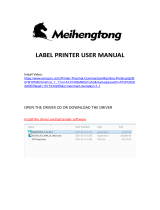
1. BARCODE PRINTER .................................................................. 4
1-1. Box content ..................................................................................................................... 4
1-2. Specifications .................................................................................................................. 4
1-3. Getting to know your printer ............................................................................................ 6
2. PRINTER SETUP ..................................................................... 9
2-1. Loading the label roll ....................................................................................................... 9
2-2. Installing the label roll holder ........................................................................................ 11
2-3. Connecting the printer to the host computer ................................................................ 12
2-4. Installing the driver ........................................................................................................ 13
3. OPERATOR PANEL ................................................................. 16
3-1. FEED button ................................................................................................................. 16
3-2. LED status .................................................................................................................... 16
3-3. Label size calibration .................................................................................................... 16
3-4. Self test ......................................................................................................................... 17
3-5. Error alerts .................................................................................................................... 18
4. ACCESSORIES ........................................................................ 19
4-1. Installing the label dispenser ........................................................................................ 19
5. MAINTENANCE AND ADJUSTMENT ...................................... 24
5-1. Cleaning the print head ................................................................................................. 24
5-2. Labels with black marks ................................................................................................ 25
5-3. Troubleshooting ............................................................................................................ 26
APPENDIX .................................................................................... 28
A. Printer interfaces .............................................................................................................. 28





















